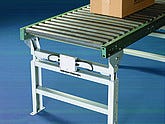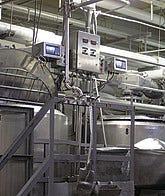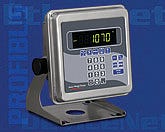Advanced Automated Electronic Scale Systems Offer Custom Solutions
September 9, 2011

Capturing precise weighing measurements is crucial for maintaining high-level process control and maximizing efficiency for a wide range of industries, such as dry processing batching and recipe blending applications. To ensure repeatable and accurate weight readings, electronic scale systems can be implemented into manufacturing processes, allowing operators to increase productivity while simplifying overall production procedures. Further, electronic scale systems improve inventory management, billing accuracy, and ensure compliance with regulation standards.
As weighing technology has advanced, electronic scale systems provide increased automation for greater process efficiency. With superior integration capabilities, automated electronic scale systems interface with plant devices and communicate with PLCs, PCs and other vital operating systems to provide an automated weighing solution. Offering a large selection of electronic scales and indicator options, with multiple features and benefits, manufacturers can design a precise automated electronic scale system to meet diverse application requirements.
Automated weighing systems provide manufacturers with greater control and visibility over the entire manufacturing enterprise. By reducing dependence on manual operators and consolidating machinery, automated electronic scale systems reduce costs, from both a labor and equipment standpoint, and save time by performing sophisticated processing procedures—making them ideal for complex batching, blending or filling applications in dry processing.
Automated Electronic Scale Systems
Manufacturing industries rely on fast-paced processing and require maximum reliability to meet market demands, all while maintaining consistent product quality. With enhanced weighing technology, electronic scale systems offer advanced automation capabilities to streamline process efficiency. Utilizing automated weighing, whether a simple system or a sophisticated solution, allows manufacturers to increase control, eliminate excess labor and reduce measurement variability.
By implementing sophisticated electronic scales interfaced with innovative indicator solutions, manufacturers create an automated electronic scale system to accommodate their processing and cost requirements. Electronic scales are available in easy-to-integrate or self-contained options, including selections that attach or replace existing manufacturing equipment, which easily assimilate into current automation.
|
Indicators allow crucial weighing data and control commands to be quickly shared throughout the entire manufacturing enterprise. |
Utilizing scale solutions, such as weigh legs—adjustable, bolt-on legs that turn manufacturing equipment into a weighing device—or conveyor scales, offer simple weighing automation for traditional manufacturing procedures. Attaching weigh legs to a conventional conveyor belt, or utilizing scales with a built-in conveyor belt permits operators to achieve in-line weighing—allowing continuous production without halting to obtain weight measurements.
In addition to electronic scales, indicators also offer features that enhance automation. By adapting to existing networks and supporting industry-standard interfaces, such as Ethernet, DeviceNet, Profibus, or other Fieldbus Interfaces, indicators maximize communication and system compatibility between electronic scales and plant equipment. Capable of delivering simple measurement displays or completing complex process management, indicators can track inventory, network with PLCs, and perform data logging—not only controlling automated electronic scale systems but also providing additional automation for the overall manufacturing process.
Indicators equipped with Fieldbus interfaces allow crucial weighing data and control commands to be quickly shared throughout the entire manufacturing enterprise. Through this connectivity, indicators signal PLCs to activate electronic scales, dispense product and control assembly movement—simultaneously automating both weighing and manufacturing procedures. For complete process visibility, indicators can generate status scripts or bar graphs to provide operators with constant real-time status updates for the highest level of weighing control for any application.
Benefits to Automated Weighing
Maintaining accurate weight measurements significantly impacts diverse aspects of manufacturing and processing procedures. By achieving consistently correct weights, operators increase inventory control, product quality and customer satisfaction, all while decreasing labor and production costs. Utilizing automated electronic scale systems offer unmatched reliability with greater process visibility and control to minimize the effects of human error—saving money, time, and labor.
Inventory Management
Automated electronic scale systems with advanced data logging and communication capabilities provide real-time product inventory updates. Indicators can track and monitor product usage or remaining amounts, communicating information to office computers. This enables the indicator to signal when product inventory is low and reordering is necessary. For example, indicators can be programmed to measure the weight of a tank after each time the product is dispensed, repeatedly calculating the amount left. The indicator automatically totals product usage and eliminates risks of shortage and surplus concerns.
Quality Control
|
By supporting industry-standard interfaces, such as Ethernet, DeviceNet, Profibus, or other Fieldbus Interfaces, indicators maximize communication and system compatibility between electronic scales and plant equipment. |
Performing quality control is essential for ensuring consistent product output, maintaining customer satisfaction or compliance with industry regulations. Quality control procedures also demonstrate that products comply with specific industry regulations. Implementing automated quality control significantly increases accuracy and efficiency. Utilizing indicators with checkweighing features enable manufacturers to perform frequent quality checks, while eliminating the need for a separate checkweigher and manual supervision. By simply entering upper and lower weight limits or using sample mode, indicators can be configured to perform standard deviation or deliver X Bar R statistical data, ensuring customers receive the correct value for their investment and manufacturers are not losing revenue from inaccurate measuring.
Reduced Labor and Cost
Self-contained, automated electronic scale systems provide maximum integration with manufacturing equipment and communication devices. By minimizing manual operation to monitor and control the assembly process, manufacturers can increase accuracy and reduce costs. Condensing complex weighing operations into a few pieces of sophisticated equipment allows facilities to effectively lower the costs associated with manual labor and equipment requirements.
In the Field
|
Manufacturers can integrate a custom automated electronic weighing system with existing manufacturing equipment for superior automation in product batching, minimizing the effects of manual miscalculations. |
With unique challenges, such as achieving exact weights with free-flowing materials and correctly measuring recipe component precision, dry processing applications benefit from weighing automation for increasing efficiency and maximizing accuracy within the dry processing industry. By combining automated electronic scales with innovative indicators, manufacturers can integrate a custom automated electronic weighing system with existing manufacturing equipment for superior automation in recipe blending or product batching, minimizing the effects of manual miscalculations.
For recipe blending applications, using indicators that store crucial measurement information, such as recipe components, ensure the exact amount of each ingredient is dispensed, without requiring operator intervention. Once the measurement parameters have been entered into the indicator—usually consisting of weight ingredients and timed events—the automated weighing systems can be configured to recall recipes, automatically measuring according to the specified weight values or percentages. The scale systems can accommodate rapid product switchover, controlling multiple weighing requirements in a single application while ensuring high-quality results.
Further, to automate filling applications with free-flowing materials, manufacturers can utilize a conveyor scale. The conveyor will regulate product motion while the vibration settles free-flowing materials for precise product distribution and highly accurate weight readings. Also, utilizing enhanced indicators networked with plant PLCs, automates the entire weighing process. The indicator will signal the PLC to set the conveyor in motion—bringing packages onto the scale. Then the indicator communicates with the PLC to open the product bin and begin dispensing, while simultaneously signaling the scale to vibrate. Once the correct weight is reached, the indicator tells the PLCs to cease product flow and to set the scale conveyor in motion, guiding the package through the assembly line. For additional automation, indicators can be configured to track product usage, keeping a running total for inventory purposes—maximizing process efficiency and reducing inaccuracies due to operator error.
Conclusion
Interfacing electronic scales and advanced indicator solutions offer weighing systems that adapt to diverse industry applications. By offering precision weighing, repeatable readings, and increased efficiency, automated electronic scale systems maintain high-level product quality while reducing labor and cost requirements.
Don Halbert is Global Product Manager with Avery Weigh-Tronix (Fairmont, MN). For more information call 800-368-2039 or visit www.averyweigh-tronix.com.
About the Author(s)
You May Also Like







